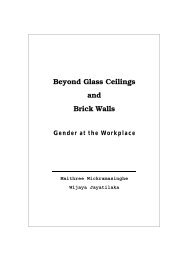SETP No. 14 The Economic Value of Incremental Employment in the ...
SETP No. 14 The Economic Value of Incremental Employment in the ...
SETP No. 14 The Economic Value of Incremental Employment in the ...
Create successful ePaper yourself
Turn your PDF publications into a flip-book with our unique Google optimized e-Paper software.
7.41 Table 7.4 is sourced from Tables 7.4 and 7.9 and <strong>in</strong>dicates <strong>the</strong> cost differential<br />
that might be applied to labour for differ<strong>in</strong>g ground conditions. Hence on s<strong>of</strong>t<br />
ground this cost premium can be as high as 36%, <strong>in</strong> average conditions 30% and<br />
<strong>in</strong> difficult terra<strong>in</strong> 24%.<br />
Table 7-<strong>14</strong><br />
Cost differentials between operat<strong>in</strong>g cost and implicit local content cost<br />
Costs per m 3 for a 10 ton wheeled loader with 1.9 m 3 bucket with 48% import component<br />
Actual cost Implicit local content cost Cost differential<br />
S<strong>of</strong>t conditions 5.0 9.2 36%<br />
Average conditions 6.0 11.0 30%<br />
Difficult conditions 7.5 13.8 24%<br />
Conclusion<br />
7.42 It has been shown that <strong>the</strong> macro economic effects <strong>of</strong> a certa<strong>in</strong> labour-based<br />
construction operation are greater than those <strong>of</strong> equipment-based construction. A<br />
case can <strong>the</strong>refore be made for a f<strong>in</strong>ancial premium for <strong>the</strong> substitution <strong>of</strong> labour<br />
for equipment.<br />
7.43 <strong>The</strong>se results are sensitive to <strong>the</strong> imported component <strong>of</strong> locally manufactured<br />
construction equipment. <strong>The</strong> factor that most effects size <strong>of</strong> <strong>the</strong> f<strong>in</strong>ancial premium<br />
is <strong>the</strong> degree to which <strong>the</strong> capital cost <strong>of</strong> <strong>the</strong> equipment has been amortised.<br />
Compar<strong>in</strong>g <strong>the</strong> macro economic effect <strong>of</strong> labour aga<strong>in</strong>st new earth mov<strong>in</strong>g<br />
equipment with a 71% imported component <strong>in</strong>dicates that a labour premium <strong>of</strong><br />
over 50% is justified. However once <strong>the</strong> capital cost is fully amortised <strong>the</strong>n this<br />
premium falls to 4%. Similarly compar<strong>in</strong>g labour to a mach<strong>in</strong>e with 48% import<br />
component calls for a 32% labour premium when <strong>the</strong> mach<strong>in</strong>e is new but aga<strong>in</strong><br />
only 4% when fully amortised.<br />
7.44 An alternative approach that looks at <strong>the</strong> direct cost <strong>of</strong> labour and equipment –<br />
ra<strong>the</strong>r than <strong>the</strong> macro economic effects – concludes that under certa<strong>in</strong> conditions<br />
labour can compete directly with equipment and result <strong>in</strong> no cost premium.<br />
However as ground conditions deteriorate <strong>the</strong> cost premium between labour and<br />
equipment opens rapidly. <strong>The</strong>se calculations are based on fixed estimates for<br />
labour productivity. <strong>The</strong> reality <strong>of</strong> labour-based projects is that labour productivity<br />
rates can be improved after tra<strong>in</strong><strong>in</strong>g over <strong>the</strong> duration <strong>of</strong> <strong>the</strong> programme.<br />
7.45 Alternatively, it can be shown that if we view <strong>the</strong> import component <strong>of</strong> locally<br />
manufactured earth mov<strong>in</strong>g equipment as ‘lost’ expenditure (lost to <strong>the</strong> country)<br />
<strong>the</strong>n labour can compete f<strong>in</strong>ancially with equipment under a much greater range<br />
<strong>of</strong> physical conditions and wages. This methodology yields a cost premium <strong>of</strong><br />
36% <strong>in</strong> s<strong>of</strong>t conditions fall<strong>in</strong>g to 24% <strong>in</strong> difficult conditions.<br />
60
















